Coal Fired Power in Oregon: Difference between revisions
| Line 92: | Line 92: | ||
Natural gas is now often cheaper than coal in the United States. Power plants are now moving from coal to natural gas on a large scale. Coal producers aren't selling as much product. | Natural gas is now often cheaper than coal in the United States. Power plants are now moving from coal to natural gas on a large scale. Coal producers aren't selling as much product. | ||
Coal producers hope China will take up the slack | Coal producers hope China will take up the slack and want to build export facilities in Washington and Oregon. | ||
[[File:Coaltrainroute.jpg|center|700px|Planned Coal Export Facilities]] | [[File:Coaltrainroute.jpg|center|700px|Planned Coal Export Facilities]] | ||
Revision as of 22:56, 22 January 2013

<< Back to: Green industry <<
Introduction
Coal. The United States is the Saudi Arabia of coal. We've got more coal than just about anybody. Half the electricity generated in the United States comes from coal. Today, more than 90 percent of the coal used in America goes to make electricity, according to an NPR documentary on coal. Clean coal advocates call it "America's new green energy."

But coal is the largest contributor to the human-made increase of CO2 in the atmosphere, causing climate change. It interferes with groundwater and water table levels. It causes acid rain and has a host of other issues.
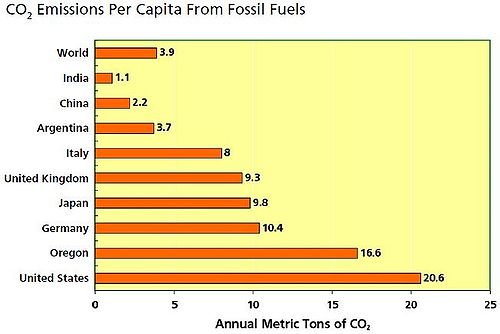
In the Northwest, we're lucky to not be dependent on coal. But it's cheap and plentiful. Coal is not going away.
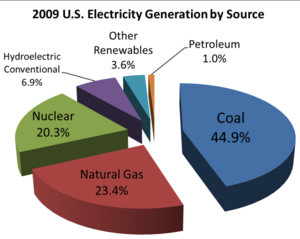
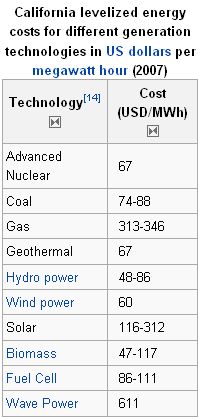
Coal plants generate power for three cents a kilowatt hour. "Clean coal" isn't a type of coal but a process to clean it up, capturing particulates and green-house emitting carbon dioxide. It's an expensive process.
Clean coal costs 6 cents a kilowatt hour.
Most renewable projects, like wind and solar, are in the range of 15 to 20 cents a kilowatt hour.
In the United States, electricity generation accounts for nearly 40 percent of greenhouse gas emissions, the largest of any source.
The Obama administration in March, 2012 has proposed the first-ever limits on heat-trapping pollution from new power plants, ignoring protests from industry and Republicans who have said the regulation will raise electricity prices and kill off coal, the dominant U.S. energy source. But the proposal also fell short of environmentalists' hopes because it goes easier than it could have on coal-fired power, one of the largest sources of the gases blamed for global warming.
"The standard will check the previously uncontrolled amount (of carbon pollution) that power plants ... release into our atmosphere," said Lisa Jackson, head of the Environmental Protection Agency.
Coal Fired Powerplants
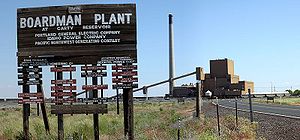
The Boardman coal-fired plant accounts for 15 percent of the power provided by PGE, Oregon's largest electric utility. Pacific Power's share of coal is 40%, according to Washington State's online reports (pdf).
PacifiCorp relies on a fleet of 26 coal-fired boilers at 11 locations in Montana, Wyoming, Utah, Arizona and Colorado, reports the Oregonian. Those plants provide almost two-thirds of the electricity consumed by customers in its six-state territory, and their low-cost output partly explains why Pacific Power's rates in Oregon remain lower than PGE's. But PacifiCorp's reliance on coal plants brings the utility to an expensive juncture, says the Oregonian.
Facebook’s data center in Prineville, Oregon is receiving a “green” backlash since its electric utility, Pacific Power, will likely be getting most of its power from a coal-powered generator in Boardman, Oregon.
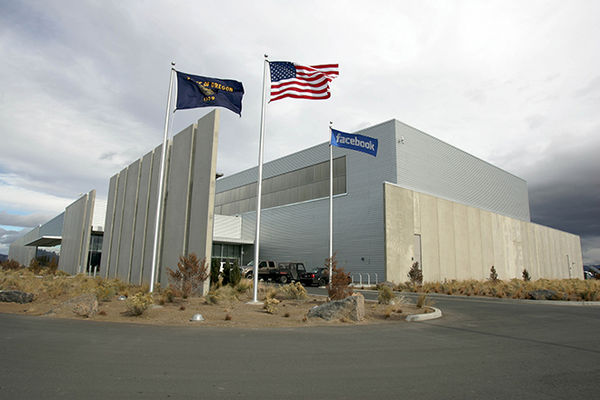
Like other data centers from Google, Amazon and Microsoft which are located along the Columbia for cheap electricity, Facebook is designing its own data centers. The company’s facility went live in Prineville, Oregon at the beginning of 2011, wringing every watt from its coal-powered electric utility.
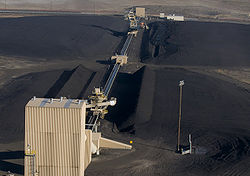
Apple's data center in Maiden, North Carolina is powered by coal, but Apple is building a 20 MW solar array plus a 5 MW fuel cell farm that it plans to run entirely on biogas (eventually).
Apple bought 160 acres in Prineville near the Facebook data center and is now constructing a 10,000 square-foot, server farm.
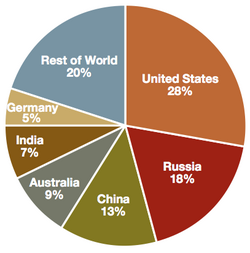
Apple's 31-megawatt data center in Prineville will use enough energy to power five cities of Prineville's size, according to The Oregonian. The Oregon facility will open using only renewable energy, according to Chief Financial Officer Peter Oppenheimer.
Facebook avoided tiered energy rates, due to a formula used by the Bonneville Power Administration, the federal agency that operates dams on the Columbia River and sells the power at cost to utilities.
Pacific Power supplies Prineville electricity from the nearby Boardman coal-fired plant.
No active commercial coal mines remain in Oregon, and the state plans to phase out Oregon's last coal-fired plant in Boardman by 2020. Still, almost 40 percent of the state’s electricity still comes from coal-burning power plants, mostly from Pacific Power's coal-fired plants.
The Global Coal Market
Coal currently accounts for 28 percent of the world’s energy consumption and generates 42 percent of the world’s electrical supply. The U.S. has 28 percent of global coal reserves, but just nine export terminals — all on the East Coast. The only West Coast options are three terminals in British Columbia, but producers in the coal-rich Powder River Basin of Montana and Wyoming are thirsty for a new path to meet demand from developing nations like China.
U.S. coal consumption fell nearly 5 percent last year to just over 1 billion short tons, according to data from U.S. Energy Information Administration. It’s expected to fall another 4 percent this year to 962 million tons.
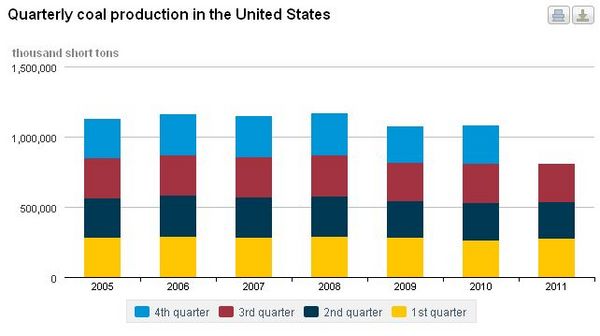
Global energy use is projected to grow by 53 percent through 2035. Rising Asian demand has prompted coal companies in Montana and Wyoming's Powder River Basin [1] to push hard for Northwest export space.
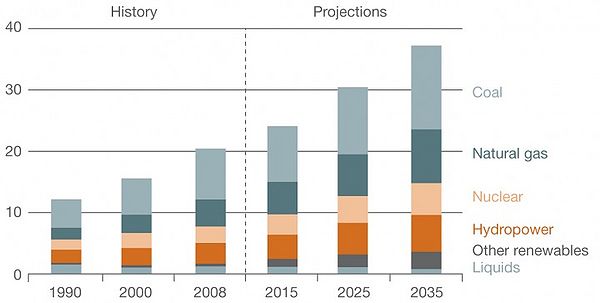
Arch Coal’s Black Thunder is the biggest mine in the Powder River Basin.
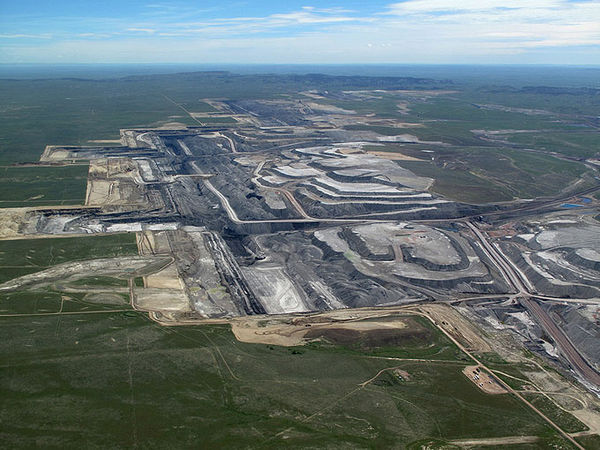
Coal Export Proposals for the Columbia River
Exporting coal to Asia from Oregon is on the front burner[2] since other West Coast facilities are at capacity and the Columbia River region is a straight shot from the Powder River Basin where the coal is, in southeast Montana and northeast Wyoming. China has lots of coal - but it's up north, far from most of the industry in southern China. Half a dozen major coal export terminals have now been proposed for the Northwest. If all of the projects were built, as much as 150 million tons of coal per year could be exported from the Northwest, nearly 50 percent more than the nation’s entire coal export output last year, reports the NY Times.
| Name | Location | Tonage | Backer |
|---|---|---|---|
| Cherry Point Gateway Pacific | Bellingham WA | 48 | SSA Marine |
| Port of Gray's Harbor | Aberdeen WA | 5 | Puget Sound and Pacific Railroad - Rocky Mountain coal |
| Millennium Bulk | Longview OR | 44 | Amber Energy |
| Port Westward Project | Clatskanie OR | 15 | Kinder Morgan |
| Morrow Pacific | Clatskanie OR | 8 | Amber Energy |
| Port of Coos Bay | Coos Bay OR | ? | Mitsu |
The United States uses about 1 billion tons of coal a year, with about 40 percent of the coal currently coming from the Powder River Basin. It is the single largest source of coal mined in the United States, more than twice the production of second-place West Virginia, and more than the entire Appalachian region.
The market for coal is receding in the United States. New pollution restrictions on coal-fired power plants were enacted by Congress in 2012, increasing the cost of operation. At the same time, huge reserves of much cleaner Natural Gas are now available, relatively inexpensively, enabled by the fracking process.
Natural gas is now often cheaper than coal in the United States. Power plants are now moving from coal to natural gas on a large scale. Coal producers aren't selling as much product.
Coal producers hope China will take up the slack and want to build export facilities in Washington and Oregon.

The opposition group, Friends of Columbia Gorge has a Presentation that shows an overview of the coal fields in the Powder River Basin, in southeast Montana and northeast Wyoming, and the expected coal train route through the Northwest.
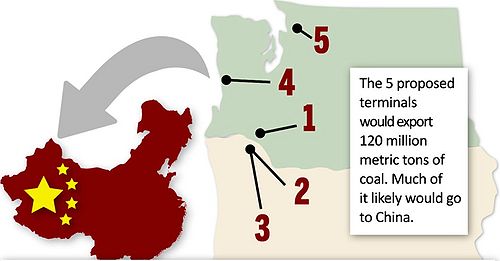
Last year, China imported 182 million metric tons of coal, surpassing Japan as the world's largest coal importer. That amount is more than the capacity of four existing coal terminals in Alaska and British Columbia and five proposed Pacific Northwest terminals combined — including one proposal in Longview and two near Clatskanie [3]. Still the coal export facility in Cherry Point, WA, and a coal export facility in Grey's Harbor would add an additional 10 trainloads daily to the 10 trainloads of coal bound for Longview, WA (not to mention Point Westward, Oregon). Presumably that totals more than 20 trainloads daily. With a 15 minute wait for each 1.2 mile train, coal trains would have a significant impact on vehicular traffic in the region.
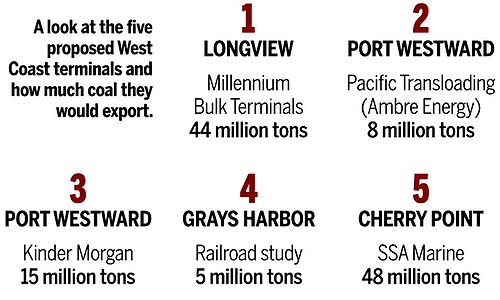
A figure of one coal train a day to deliver 5 million tons a year has been used by some, but that figure requires substantiation. According to Carrix/SSA, the total number of coal train trips per day (arriving full, leaving empty) to transport 48 million tons of coal per year would be in the range of 16 to 18, reports CoalFreeGorge. If you divide 48 tons by 16 train trips, that seems to indicate 3 tons per year per train trip (coming and going).
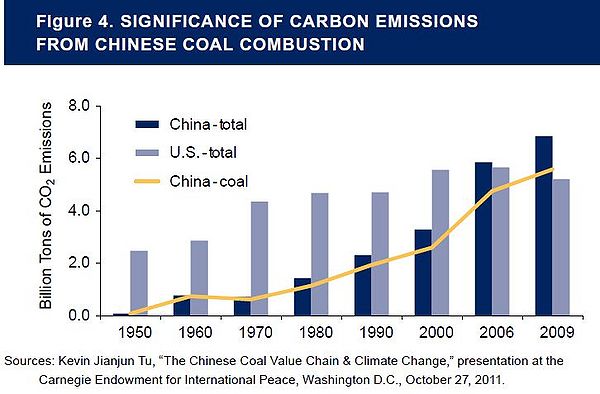
Exporting 150 million tons of coal produces about as much carbon dioxide as 60 million cars, notes the Washington Post. Would blocking these export terminals have any impact on the growth of coal in China? There’s some evidence that it could. Still, global warming politics may not be as heated as the increasingly bitter battle between jobs vs the environment.
Coal Export Proposal for Longview
Millennium Bulk Terminals, a subsidiary of Australia's Ambre Energy [4], plans to build the first major U.S. coal export terminal on the West Coast in Longview [5]. Millennium would build their coal export facility in Longview, Washington[6], and has now greatly expanded their plans[7].
Instead of shipping 5.7 million tons of coal a year, as originally proposed, it now plans for a $600 million terminal to ship 44 million tons a year, from Longview[8]. It would be the largest such coal terminal in North America, The Daily News of Longview reported on February 23, 2012. The proposed Gateway Pacific Terminal, in Cherry Point, Washington, would have a similar capacity - around 48 million tons of coal a year.
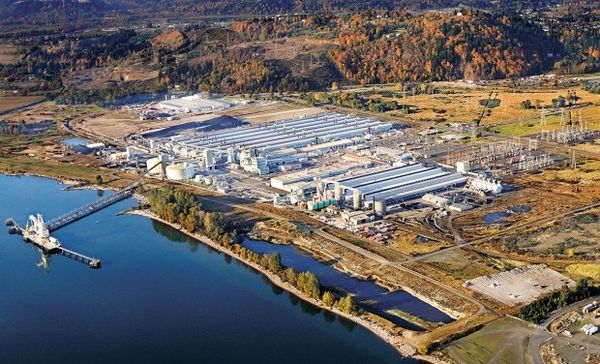
Millennium Bulk Terminals, is planning to develop a 406-acre Reynolds facility in Longview, Washington into a coal terminal, reports TDN[9]. Millennium's CEO, said he thinks projected Asian demand for coal could support "multiple" terminals on the Columbia River.
The proposed export facility [10] would ship from 5 to 60 million tons of coal to Asia annually. Five million tones is an amount said to be roughly equal to the amount of coal burned in the whole state of Washington, reports SustainableBusinessOregon [11].
The New York Times reported on Feb 4, 2012 [12], that court records show that leaders of the company planning to build the facility, now called Millennium Bulk Terminals, tried to limit what state officials knew about its long-term goals during the early permitting process last year.
The company’s initial application [13] described a facility that could export up to five million tons of coal per year. But court records show that the company hoped to greatly expand that amount in a second phase to 20 million tons or even 60 million tons annually.
Opposition groups, led by Portland-based Columbia Riverkeeper [14], have already come out against both plans, saying they're worried about the health effects of coal dust in the community and a large number of coal trains clogging vehicle traffic.
Landowners and Citizens for a Safe Community [15] formed last year to protest the proposed $600 million coal terminal from Millennium Bulk Terminals at the former Reynolds Metals Co. site west of Longview [16].
Two Coal Export Proposals for Clatskanie, Oregon's Port Westward
In January, Port of St. Helens commissioners approved lease options for two coal terminals for Port Westward. The five-member The Port of St. Helens[17] commission unanimously approved a lease option from Pacific Transloading, a subsidiary of Amber Energy, to operate their barge dock. They also voted 4-1 to approve a lease option from Houston-based energy giant Kinder Morgan to build a rail-fed coal terminal for Port Westward.
Two giant energy companies have submitted separate proposals to develop coal export facilities at Port Westward [18]. It would be located on the Columbia, north of Clatskanie, Oregon [19], potentially making the Columbia River a major thoroughfare for transporting coal to Asia. If approved, the two projects would add more than 100 jobs.
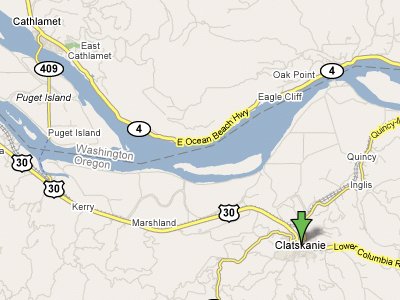
Kinder Morgon Coal Export from Port Westward
The Kinder Morgan terminal [20] would create 80 family-wage jobs at the port, according to Patrick Trapp, director of the Port of St. Helens [21], which operates Port Westward.
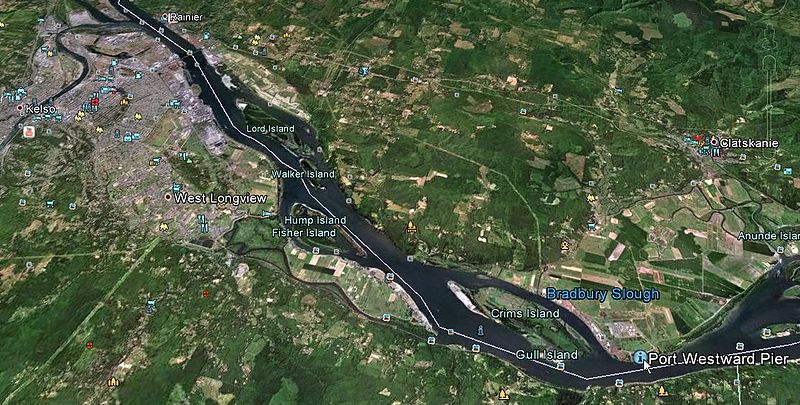
Port Westward (above), on the Oregon side, is about 12 miles downriver from the proposed Longview coal export facility.
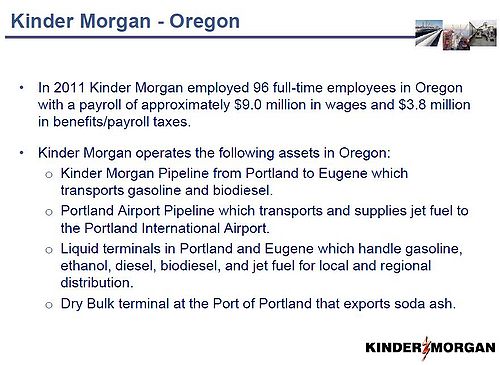
Kinder Morgan's $150 to $200 million facility at Portwestward would use coal trains (company fact sheet). It would export about 15 million tons of coal annually.
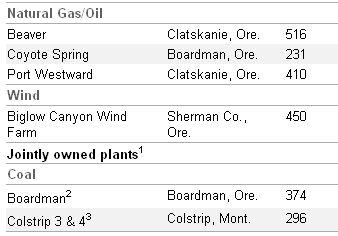
Scott Learn, of the Oregonian reports[22] that the agreements with Kinder Morgan and Ambre Energy would provide construction work and up to 105 full-time jobs.
UPDATE: Portland General Electric has apparently blocked Kinder Morgan’s plans for a coal export terminal.
PGE renewed a 99-year lease in 2008 on 852 acres of developable land at the Port of St. Helens-owned land near Clatskanie.
In turn, PGE can sublease the property. But PGE – which itself runs two power-generation facilities on that property – decided in mid-April that Kinder Morgan's facility could have detrimental effects on its own operations.
PGE spokesman Steve Corson told the Spotlight May 2 his company felt the presumed coal dust that would come from the export terminal might harm its significant investments if Kinder Morgan moved in next door.
Ambre Energy/Pacific Transloading Coal Export from Port Westward
A second coal export facility, Pacific Transloading, has also been proposed for the same Port Westard location. It differs from the Kinder Morgan proposal in that it plans to barge coal to Port Westward. It would move coal on barges down the river from Port Morrow[23] in Central Oregon to ships docked at the Port Westward export facility. Pacific Transloading says it would only export about 8 million tons of coal annually.
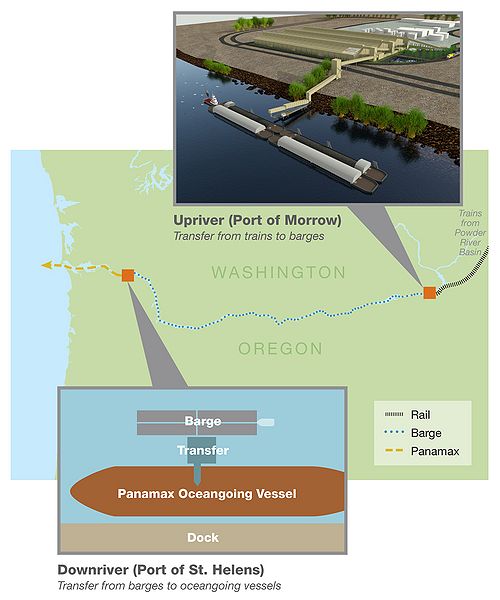
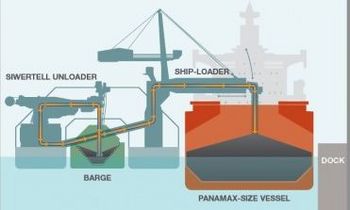
Pacific Transloading is a subsidiary of Australian coal giant Ambre Energy[24].
Amber Energy says The Morrow Pacific Project will create 25 new jobs in Morrow County and 25 new jobs in Columbia County where the coal is transferred to oceangoing barges. These will be well-paying jobs, says Amber Energy, with average salaries in the range of $50,000 to $90,000.
The Morrow Pacific project, being developed by Ambre Energy, would have an operational capacity of two barge-tows per day and would ship between 3.5 to 8 million metric tons with port approval. Coal would arrive on covered barges loaded upstream at the Port of Morrow[25], then directly loaded onto about 50 ocean-going ships a year.
Another Ambre subsidiary company, Millennium Bulk Logistics of Longview[26], is also the one hoping to build the Longview coal export, about 12 miles up the river, which would import coal by train (on the Washington side).
But Pacific Transloading's parent company, Amber Energy, can't be trusted, say critics. They mislead Longview officials on the size of their Longview proposal, initially saying the export facility would only export 5.7 million tons. On September 2, 2010, Millennium filed an application with Cowlitz County to build and operate a 5.7 million ton per year facility in Longview. But the company deliberately misled officials about the size of the project. In fact, Amber Energy was planning a facility ten times that size all along - 45 million tons to 60 million tons - or more.
Boardman burns 3 to 5 million tons of coal per year, according to Laura Stevens of the Sierra Club’s Beyond Coal campaign. Anything less than 10-15 million tons a year is a drop in the bucket to what China will need.
Coal Export from Coos Bay
In October 2011, the Port of Coos Bay [27] signed an exclusive negotiating agreement with an anonymous company interested in shipping coal from the port (document).
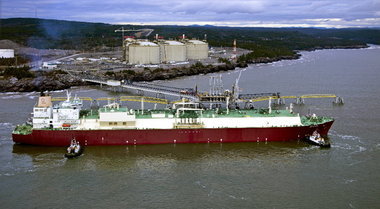
The Japanese conglomerate Mitsui and California-based Metro Ports are two of the key players in a bid to develop a coal export terminal with the Port of Coos Bay, EarthFix has learned. Environmental groups opposed to coal exportation have criticized the port’s refusal to disclose the names of its potential partners. Mitsui operates a major rail-car leasing business while Metro Ports is a stevedoring and terminal management company.
An engineering study found that a rail line between Coos Bay and Eugene needs about 100 million dollars worth of work before it can handle heavier train traffic. The study was paid for by anonymous investors interested in exporting coal from Coos Bay. Environmental groups have filed formal requests for records detailing the proposal. The port has said it would charge the groups thousands of dollars so that a lawyer could determine whether information is confidential or public under state law. Coal dust is one of the environmental groups concerns.
The port of Coos Bay wants to dredge more than 5 million cubic yards for an access channel and a new two-slip marine terminal on the bay's North Spit. It estimates the terminal would generate from 26 to 280 long-term jobs.
Opposition to Coal Exporting along the Columbia River

If all six coal export terminals are approved and fully developed, they would feed enough carbon dioxide-spewing coal plants in Asia to equal 65 Boardmans. "Then we're all toast," says KC Golden, policy director for Climate Solutions in Seattle. "It becomes mathematically impossible to stabilize the climate at safe levels," he says.
The EPA said that the Port of Morrow project has “the potential to significantly impact human health and the environment," and called for a full review of the potential impacts of exporting large amounts of coal from Wyoming and Montana to Asia.
A Sightline Institute investigation found that “500 pounds to a ton of coal can escape from a single loaded car,” using calculations by the BNSF railroad.
Oregon's governor called on federal agencies to thoroughly evaluate the environmental impacts of coal-export projects, saying the United States risks locking Asian countries into dependency on fossil fuels if it expands access to vast American coal reserves.
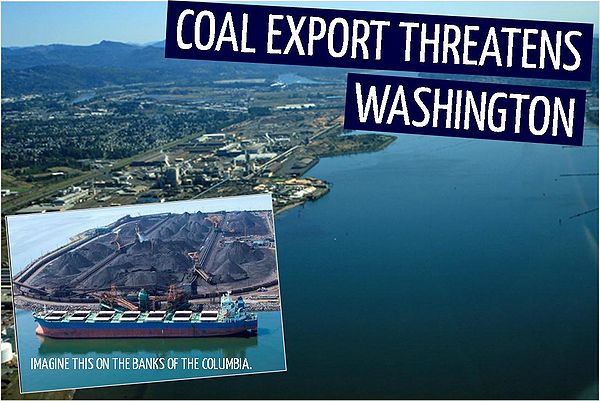
The Whatcom Docs – a large group of doctors in Whatcom County say increased Coal Train Traffic Could Mean Bad News For Public Health, with the effects of air pollution real and measurable.
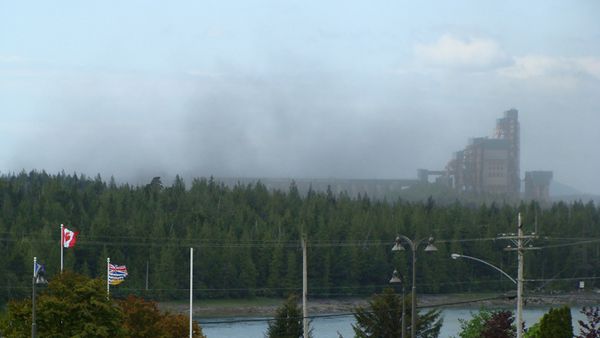
The coal cloud from BC's Port Edward illustrates the concerns about the coal dust from an export terminal.
Besides questions over the environmental impact, critics point out the terminal would snarl vehicle traffic at railroad crossings through Longview's industrial corridor.
Agreements with the Port of St. Helens were hammered out in secret, said Laura Stevens, organizer with the Sierra Club's Beyond Coal Campaign[28]. Opponents expected the commission to hear proposals from the two companies, considered publicly for the first time Jan 25, 2012, but not to vote on agreements. Instead the commissioners held a closed executive session, then endorsed the agreements that may lead to exporting coal through the port's Port Westward industrial park in Clatskanie[29].
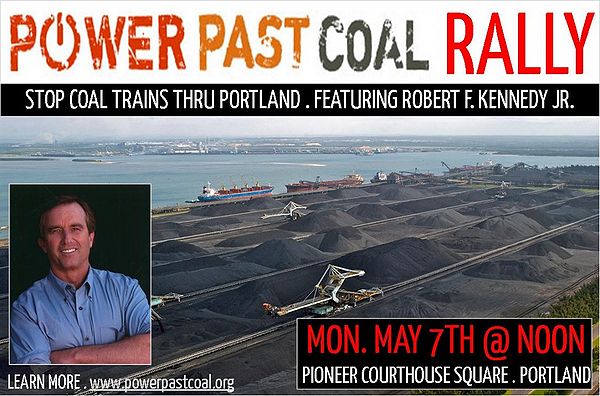
Currently, the six proposals would export a total of 146 million tons of coal every year. This would require over 50 coal trains per day, every day, including 12 trains (6 full, 6 empty) per day through North Portland, according to Columbia Riverkeepers. According to the EPA, 8.8 million tons/yr barged to Port Westward would translate to approximately 11 trains a week to the Port of Morrow, or 22 trains (round trip) each week. That might be the equivalent of 3-4 train trips a day. The Kinder Morgan Port Westward proposal, estimated at 15 tons/yr, would be about double that of the Morrow Pacific barge Proposal, resulting in 5-8, trains, each 125 cars long, passing across Oregon highways every day, to Port Westward, say transportation critics.
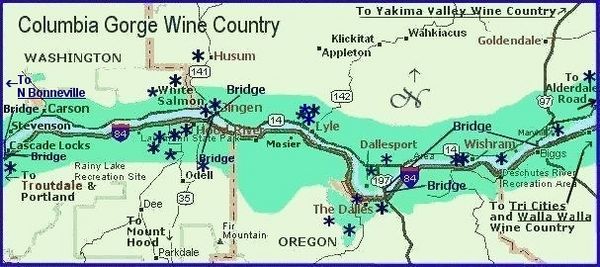
According to Oregon Gov. John Kitzhaber, the coal projects would require as many as 63 coal trains a day, traveling through "choke points", and may boost Columbia River ship traffic by 70 percent.
On April 5, the EPA submitted public comments (PDF) expressed some potential red flags:
..."Transporting and transloading up to 8.8 million tons of coal with eleven trains, twelve loaded barge tows, and two Panamax ships per week has the potential to significantly impact human health and the environment"...
According to a study by the Western Organization of Resource Councils, exporting 140 million tons of coal per year would add nearly 280 million tons of carbon dioxide to the atmosphere and require 60 trains a day to transport to the West Coast.
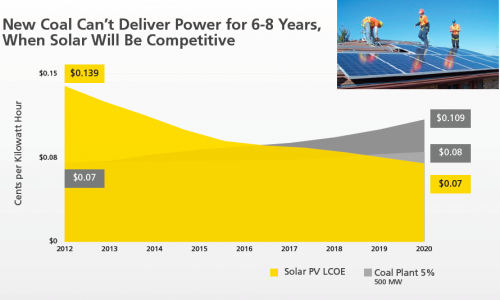
Even WITHOUT taking important health and safety costs, advocates say solar can be cost-competitive with coal and will get more so. The competitive price of natural gas, wind, and solar may make coal export to China a short-term business model doomed to collapse.
Railroad Issues
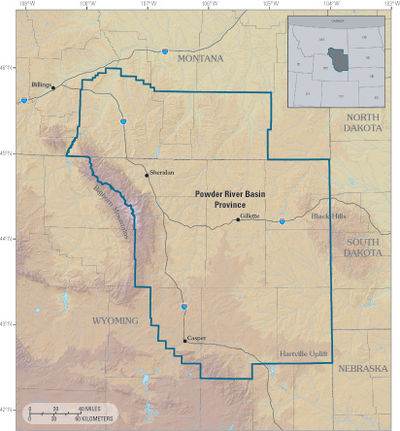
Coal accounts for more than a quarter of BNSF's revenues and 90 percent of the coal it hauls is from the Powder River Basin. Millennium plans to haul at least 45 million tons of coal per year from the Powder River Basin in Wyoming and Montana to Longview, Washington. It would use Burlington Northern's rail lines on the Washington side of the Columbia.
Kinder Morgan's $150 million to $200 million project on the Oregon side of the Columbia (pdf) would receive coal by trains, running through the Columbia Gorge. The proposed Oregon coal facility at Port Westward would use the regional Portland & Western Railroad line. Environmental groups say each 5 million tons of coal exported per year requires one mile-long train every day.
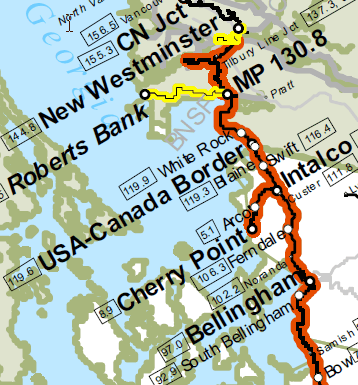
KING-5 covers The great train debateover coal facilities at Cherry Point and Longview. One key question that remains unanswered; will coal trains use the Oregon or Washington side of the Columbia River Gorge? An Oregon rail route would cause massive congestion at the intersection of the Steel Bridge and Naito Parkway, among other locations. The Washington side, not so much.
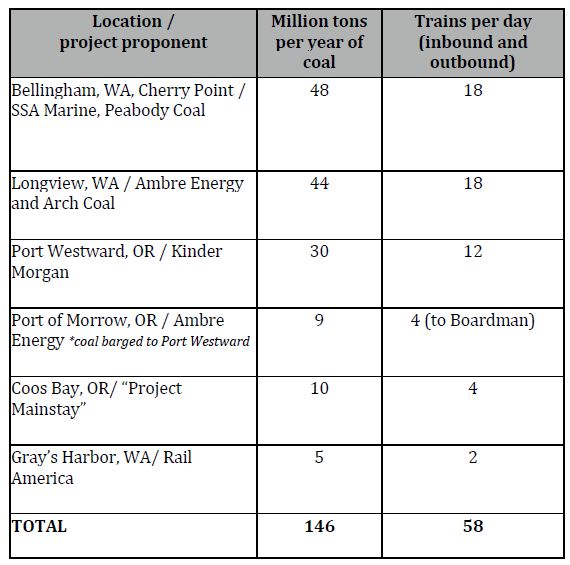
The city of The Dallas listened to a presentation by Sightline on coal export along the Columbia River (above). Critics like Sightline say trains serving Cherry Point WA would more than double the existing rail traffic. That’s before the region sees any other freight expansions, and before the region gets new passenger rail service.
Presumably Kinder Morgan's 15-30 million ton terminal at Port Westward would use the Washington side, then cross over on the rail bridge west of the I-5 Interstate bridge. Amber Energy says they'll bring coal trains to Boardman then stop - transfering coal to barges to Port Westard. But some are skeptical that Amber Energy is telling the whole truth - they did misrepresent the true size of their proposed Longview facility by a factor of ten. Consequently, Amber's barge proposal may be a similar misrepresentation, say critics.
Rainer, Oregon[30] has a single P&W track that cuts through the downtown and separates homes and businesses from the rest of the city. The tracks cross multiple streets, and speed limits force trains to creep through town. The P&W rail line goes through other communities along the Oregon side, from Portland to Clatskanie, Oregon, where Port Westward is located.
Railroad improvements tend to be costly. There is good reason to worry that taxpayers—not BNSF and not the coal companies—will be asked to expand the state’s railway system to make way for coal, say critics.
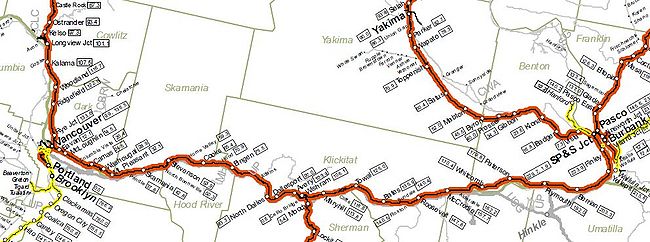
BNSF is the largest transporter of low-sulfur coal in the world while Union Pacific in Oregon moves containers, primarily. Rail transport in Oregon may be significantly affected by coal trains, creating bottlenecks.

Burlington Northern trains use the North side of the Columbia Gorge, on the Washington side. They may cross to the Oregon side using the railroad bridge, just West of the I-5 interstate bridge. At Willbridge, BNSF and Union Pacific can then join with the Portland & Western Railroad to serve Port Westward, near Clatskanie Oregon.
The Washington train route would seem to avoid at least one major choke point - Naito Parkway in downtown Portland.
Union Pacific trains use the South side of the Columbia River, on the Oregon side. Those trains come out through Sullivan's Gulch, beneath the Lloyd Center, and head towards the Steel bridge in downtown Portland. This map shows that all trains MUST cross Naito Parkway if they head down river to Port Westward. Currently, most Oregon-bound trains don't cross the Steel bridge (and Naito Parkway) because they are headed for Rivergate terminals 4, 5 and 6.
Coal trains on the Oregon side of the Columbia (from Boardman) might cross over to Washington at the Celilo train bridge, near Wishram, then cross back to Oregon at the Columbia River Railroad Bridge where it would continue downriver to Port Westward, to eliminate the bottleneck of the Steel Bridge/Naito Parkway crossing. Oregon bottlenecks down river would remain.
Amber Energy says not to worry -- they will use barges, not trains from Boardman. Some people do not believe them. Amber Energy purposely misrepresented their Longview proposal. Critics wonder if Amber's barge proposal for Port Westward could also be a railroad job.
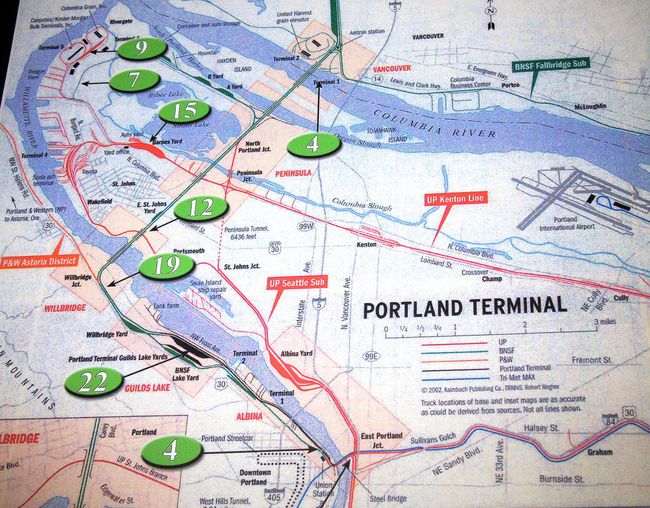
The 50-mile Portland & Western Railroad rail line[31] would have to undergo significant upgrades before any of that happens, say Oregon Department of Transportation officials. Each coal train would be 125 cars long, pulled by four locomotives[32]. A 125-car train is approximate 1.34 miles long.
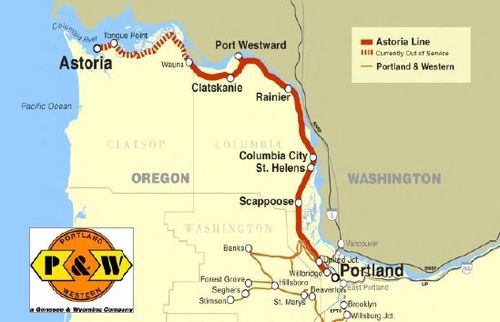
Kinder Morgan's planned 15 million ton Oregon facility might require 3-6 train runs a day, using the Portland & Western Railroad.
Going 15 mph, it might take 15-20 minutes minutes for each of 6 coal trains daily. Not to mention the current daily log trains to Teevin Brothers and trainloads now hauling grain to the new Columbia Pacific Biorefinery ethanol plant, which is restarting their operation and is co-located at Port Westward.
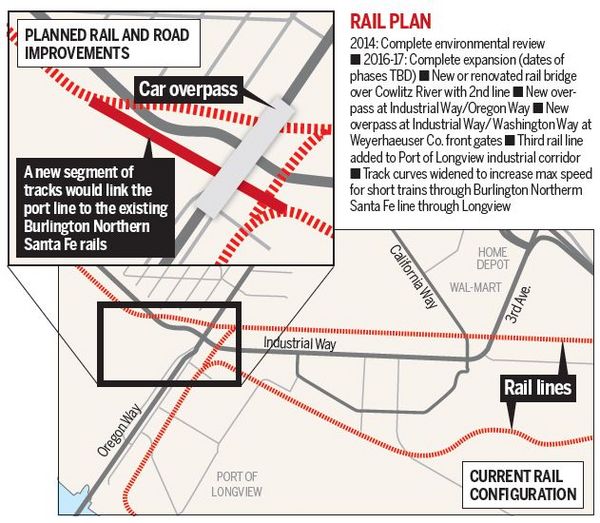
Washington planners are developing a $200 million rail expansion plan to accommodate thousands of additional coal cars going to the proposed 45 million tons/year Millennium coal terminal, west of Longview. Rail improvements would be funded by those who will benefit from it, say Port officials, including Millennium, the Port of Longview[33], Weyerhaeuser Co., Longview Fibre Paper & Packaging, local governments and other industries. Eight, mile-long trains a day would deliver coal to Longview. Including round trips, 16 coal trains a day could stop traffic at Third Avenue, Oregon Way, California Way and Industrial Way.
Kinder Morgan's proposed a $200 million terminal in Oregon's Port Westward would export about 15 million tons of coal annually by train, while Ambre Energy, planned $150 million export facility at Port Westward would export less (8 million tons), by barge. Ambre Energy would bring in coal by train to the Port of Morrow[34], then barge the coal down river to Port Westward. Presumably, if Ambre Energy actually sticks to their plan of barging coal to Port Westward, that would cause less railroad congestion on the Oregon side.
Possible Infrastructure and Employment Benefits
Greenbrier and Vigor Industrial were both asked to bid on $70 million of barge construction for the Morrow Pacific project. Tidewater Barge Lines, a Vancouver, Wash.-based barge and tugboat operator is hoping to land a lucrative contract serving Ambre Energy’s proposed $250 million Morrow Pacific coal export project. “It’s the biggest (potential) project we’ve looked at in our history,” said Dennis McVicker, CEO of 80-year-old Tidewater, which would use its tugs to guide coal-filled barges back and forth between the two ports, reports Sustainable Oregon Business. “If we’re selected to do this work, we’re going to be building four or five new boats at maybe $10 million to $11 million per boat.”
"China is building coal-fired electric power plants like crazy," says Joseph Cannon, Millennium's chief executive. "They have a near-insatiable appetite for electricity over there. So they're going to burn coal. This coal is vastly cleaner than the coal that's being burned in China. Not just less mercury, but less sulphur and less nitrogen. That's not a greenhouse gas, of course, but this will make it better for the people of China."
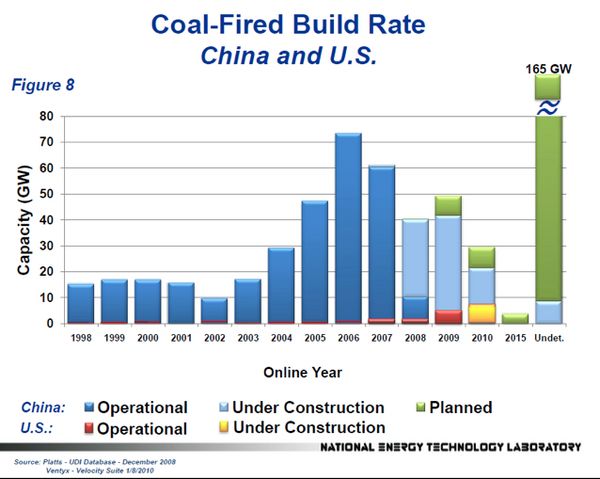

Union Pacific is said to be working with Mexican railroad Ferromex on possibly moving coal through the Port of Guaymas, about 240 miles from the US border. "We've seen a higher level of interest for export coal out of Mexican ports," said Eric Butler, Union Pacific executive vice president for marketing and sales. "They do not seem to have the same permitting process that we have had in the Pacific Northwest ports."
Seattle-based environmental advocacy group The Sightline Institute, notes how the Port of Portland entered into a 25-year lease with a group called Pacific Coal in the 1980s to export coal to Asia. But after $25 million invested, the project was scuttled in 1983 after demand from Asia proved not to be so robust.
“The Port of Portland tried a coal export terminal in the early 1980s and it collapsed,” said Brett VandenHeuvel, executive director of Hood River environmental advocacy group Columbia Riverkeeper. “The rhetoric was exactly the same as we see today. The market shifted and they never shipped a single ounce of product.”
But officials at the Port of Portland aren’t as willing to portray the 1980s coal experiment as a failure, reports Erik Siemers in Sustainable Business Oregon.
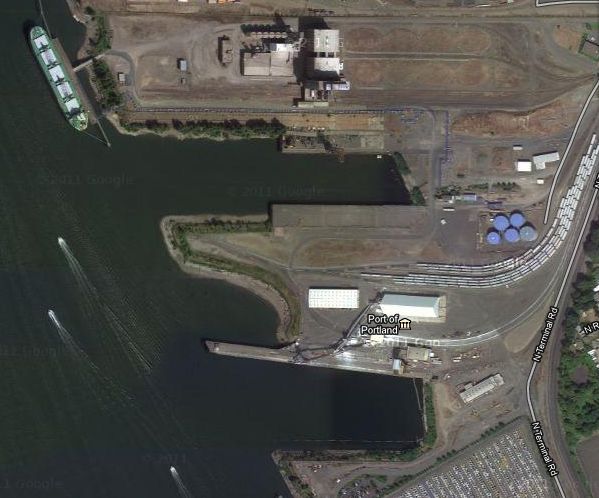
The work on that 1980s coal terminal paved the way to what is today a thriving operation at the Port of Portland's Terminal Four, exporting Soda ash from Kinder-Morgan berth 411 Google Map. In 2009, Kinder-Morgan handled approx 2 million tons of Soda Ash.
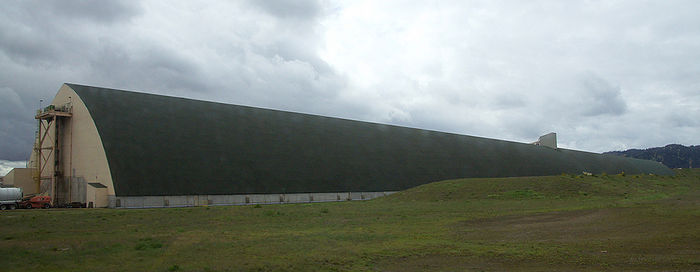
The Port of Portland's Terminal Five, uses the rail infrastructure to export potash, brought in from Canada. Potash is a bulk commodity used in fertilizers. See: Sam Churchill's tour of Terminal 5
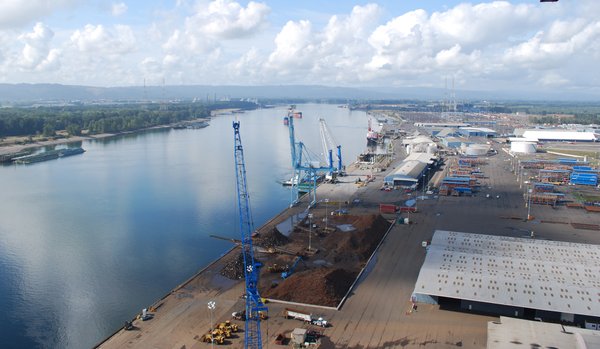
Neither the Port of Portland nor the Port of Vancouver (above) has expressed much enthusiasm for coal, due to cleaner, less problematic business opportunities. The Port of Vancouver celebrated 100 years in April, 2012. It has 2,127 acres that includes 800 acres of industrial facilities, more than 500 acres of land for future development and more than 100 acres of shovel-ready land.
Summary
Proponents of the coal export facilities say these are major facilities for the Northwest. They will bring new jobs and create large-scale infrastructure improvement for the Columbia River and the coast that will result in long term economic development and employment for the whole region. China needs coal. We've got it.
Detractors of the coal export facilities say the transportation impact and infrastructure costs will have a negative impact on the region, as well as diminishing the general health and environment. They say if coal exports don't happen on the Columbia, China will be forced to consider alternatives because exporting from the Gulf is too expensive and Canadian ports are already at capacity.
Coal is still powering the United States:
Obama: "This is America. We figured out how to put a man on the moon in ten years. You can't tell me we can't figure out how to burn coal, that we mine right here in the United States of America, and make it work. We can do that".
Soren Wheeler of RadioLab takes us to Butte Montana, home of the Berkeley Pit. Artist Edward Burtynsky produced a documentary film called Manufactured Landscapes.
References
- ↑ Powder River Basin
- ↑ Coal Export Facilities
- ↑ Oregonian
- ↑ Amber Energy
- ↑ Port of Longview
- ↑ Millennium Bulk
- ↑ Longview Daily News: Coal Export Facilities
- ↑ Port of Longview
- ↑ Longview Daily News: Coal Export Facilities
- ↑ Longview Daily News Coal Export Facilities
- ↑ Sustainable Business Oregon
- ↑ NYT Coal Clash
- ↑ Millennium Bulk Longview
- ↑ Willamette River Keepers
- ↑ Landowners and Citizens for a Safe Community
- ↑ City of Longview
- ↑ Port of St Helens
- ↑ Kinder Morgan: Port Westward
- ↑ City of Clatskanie
- ↑ Kinder Morgan
- ↑ Port of St Helens
- ↑ Oregonian: Coal Export
- ↑ Port of Morrow
- ↑ Amber Energy
- ↑ Port of Morrow
- ↑ Millennium Bulk: Longview
- ↑ Port of Coos Bay
- ↑ Sierra Club's Beyond Coal Campaign
- ↑ City of Clatskanie
- ↑ City of Rainier
- ↑ Portland & Western Railroad
- ↑ Landowners and Citizens for a Safe Community
- ↑ Port of Longview
- ↑ Port of Morrow
Links
- Longview Daily News: Coal Export Facilities
- Oregonian: Coal Export
- Sustainable Business Oregon
- Vancouver Columbian
- Earth Fix
- Ecotrope
- Portland Tribune: Sustainable Life
- NY Times: Coal Clash
- Washington Post: Can blocking coal exports impact China?
- Source Watch: Coal Exports
--
- Amber Energy: Columbia County
- Millennium Bulk: Longview
- Kinder Morgan: Port Westward
- Morrow Pacific: Port Westward
- Amber Energy Proposal for Port Westward/Port Morrow
- Gateway Pacific Terminal proposal for Cherry Point, Washington
--
--
- Carl Abbott: Portland’s Working Rivers: Their Heritage and Future
- Sightline.org: Northwest Coal Exports
- Exporting Powder River Basin Coal: Risks and Costs
- Sierra Club: Coal-Free Northwest
- Sierra Club: Beyond Coal Campaign
- Coal Diver
- Coal Train Facts
- Coal on a Roll
--
- Landowners and Citizens for a Safe Community
- Communities for a Coal Free Gorge
- No Coal Eugene
- Willamette River Keepers
- Video on Powder River Basin
- Cherry Point Coal Opposition Video
--
--
- Port of Morrow
- Port of Portland
- Port of Vancouver
- Port of Longview
- Port of St Helens
- Port of Kalama
- Port of Astoria
- Port of Coos Bay
--
NEXT: Natural Gas in Oregon
Back to: Green industry <<